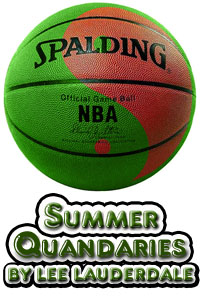Post by FLCeltsFan on Sept 8, 2016 19:59:34 GMT -5

SQ2016-10 Speed As A Weapon
My first view of the 2015 draftees Terry Rozier and Marcus Thornton came in summer league. What immediately stood out was that each had a first step that got separation. Mostly they employed this edge in quickness to seek their own shot—a useful, but potentially limiting, value for a point guard whose primary duties should also include quarterbacking the team and setting the table for his teammates. It was, however, sufficiently eye-catching that I followed them as they moved around the court rather than ball-watching (which, admit it, is the primary mode in which we fans watch the game). This led to some interesting observations (at least to me.)
This hyper-gear which both possessed, was not evenly applied. For Rozier, this cat-like quickness was also quite evident on defense where he used and controlled this tool to maintain his position between opposing guards and the basket. With Thornton, not so much. He didn't have that first step on defense, or at least it was retarded by a delayed reaction. It seemed his burst of catch-up speed often left him overrunning his assignment when his man changed direction or stopped. It dawned on me that although their ability to move like lightening was similar, especially on that first step, there was a vast difference in their capability to control the quick burst—stopping was very nearly as important as starting, so was changing direction.
My first thought was that perhaps this start-stop-change-direction difference might be due to size, or perhaps strength. Checking their combine stats, it seems that while Thornton is an inch taller, a year older and 10 pounds lighter. Rozier managed almost twice as many bench presses, and has a slight edge in agility, and sprint numbers. Thornton came out as a senior while Rozier was only a sophomore. I just don't see any obvious differentiator reasons here.
In subsequent observations, admittedly a lot for Rozier and very few for Thornton, my initial impressions stand up. Rozier's ability to apply his quickness across the needed range of basketball activity shows a clear edge over Marcus Thornton. In watching their overall play and progress, it seems like this difference in the use of quickness plays a significant role in explaining why Terry Rozier is likely to have a solid role in the Celtics' rotation, while Marcus Thornton languishes overseas.
I have used the phrase “ability to apply” as the difference between these two guards, and I think that bears a second look. If their physical abilities are so similar, why such a difference in actual use? I have to consider the idea that Rozier is more willing to expend energy to employ his quickness on the defensive end. The persistent drive for Thornton to seek out his own offense, whether in summer league or Australia, does not seem to be matched by a similar investment at the other end of the court. It is not enough to have athleticism, you have to be willing to invest it in your entire game, not just the “fun” part. Perhaps this attitude, or lack thereof, explains why Terry has made a lot of progress while Marcus seems to be the same player he was last summer.
While the contrast in these two “quick” guards led me into this line of thought and discussion, it has summoned up a whole wave of ideas about speed. The ripples of those waves has led me into a broader arena of “behind the story” notions about the less metrically available facets of basketball which I hope to explore in the coming days. It seems to me that there are several more “sides” to the speed issue, most of which don't show up on the stat sheet. Speed and quickness can have a big impact on the opposition's ability to run their offense (disrupting plays, shortening the shot clock, impeding ball and player movement, quality of shots taken or allowed, or just getting the ball down court). Speed can shape your offensive approach, both individually and as a team. Most of this shows up only obliquely, if at all, in any statistics (steals, shots taken, fast break points each capture just a small piece of the effects of speed and quickness).
In addition to the effects of speed and quickness, I have begun to contemplate other qualities of the game that might be broadly labeled force multipliers (a term borrowed from the military which seems apt since each season [game, practice, possession] is, in truth, a campaign of offensive forces vs. defensive ones). In coming days I hope to explore such ephemeral contributions such as coaching strategies as well as those of the GM, running (and I mean all the time [cue Tommy “Run, baby, run”], players subverting their own egos to facilitate ball-sharing offense, Brad Stevens' 28-20 time splits vs. the more traditional 36-12 or 34-14 distributions, and the overall concept of depth and fatigue. I invite you to ponder-ahead in preparation to adding to and/or correcting my meandering thoughts.[Discuss on CG Forums!]




